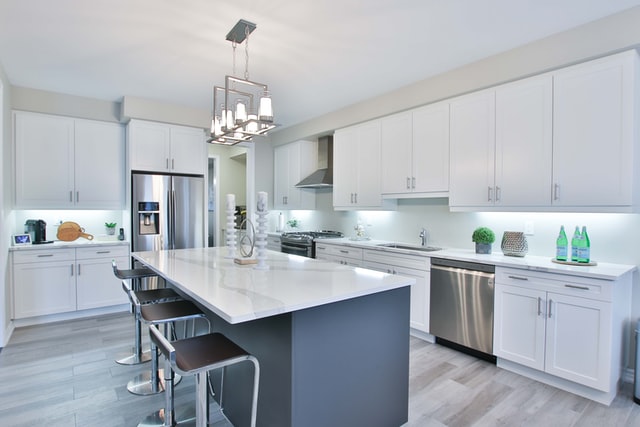
The kitchen is the heartbeat of your home. When the aesthetics and lighting aren’t right, it can feel like everything is a little off as you go about the business of your day.
Although many people focus on the appliances, faucets, cabinets, or countertops when designing an appropriate space, the first step should be to examine your lighting fixtures.
Without functional lighting, the rest of your design doesn’t make sense.
Since you have several options from which to choose, including sconces, schoolhouse lights, chandeliers, recessed lights, and pendants, how can you make the right choice for your home?
Create a Statement in Contrast

If you have a kitchen with a patterned backsplash, busy designs, and lots of texture, it helps to choose a fixture that feels airy and subtle. Having a light touch in this circumstance illuminates that space’s best attributes without feeling like an overwhelming experience.
When your kitchen is minimalistic, with simple details and a straightforward design, choose fixtures that make a definitive statement instead. You can go as big and as bold as you want.
Compliment the Décor

A kitchen’s lighting features should work with the décor elements you’ve selected for that space. Although there aren’t any specific guidelines to follow, it helps to use metals, geometric shapes, and sharp lines with your lighting in a modern kitchen. When you have something coastal or cultural as part of the design, the fixtures should offer something more natural and organic.
The result you experience should be a direct reflection of who you are. Many of the best designs incorporate fixtures from multiple elements to highlight the best attributes of this space.
Size Doesn’t Matter… Unless It Does

Most kitchens use small glass pendants as a lighting fixture because the design creates a traditional look without being overly distracting. If you have a great room, larger items can create room definition or separation without the need for a wall.
The size of what you choose doesn’t matter unless it becomes the only thing you can see about your kitchen. Even a statement piece can communicate a specific décor style without being overwhelming. If you think the item you want is too large, you’re probably right.
Structure Your Lighting in Layers

Lighting needs in the modern kitchen must meet particular expectations. It would be best to have specific fixtures for cooking and food prep, which are different from the ambient lights that offer the general illumination for your space. Accent lighting delivers character, highlighting specific aspects that you love – such as some artwork or the subway tile backsplash you installed.
When you deliver lighting in layers, the different plays on shadow and contrast create a delightful room where everyone wants to be. Try to select fixtures that help you achieve this goal.
Consider Your Safety Needs
Safety requirements for kitchen fixtures may have several different approaches to manage. If you install lighting for your food prep zones, there shouldn’t be any shadows that get in the way of your work. It helps to install task lighting above or in front of where you’ll be to avoid this issue.
Track systems, LED light strips, and hanging fixtures shouldn’t interfere with your cooking or cleaning activities. If they collect grease splatter, the installation might become a fire hazard without daily cleaning.
Review Your Overall Spacing
Spacing around and between your light fixtures is a crucial component of your kitchen design. If you have an island to accommodate in your space, the lighting should cover the surface you plan to use while providing a calming visual aesthetic. The installation should be centered above the elements, with an equal amount of space provided for multiple units.
First, you’ll want to account for the equal space requirements needed for multiple pendants or fixtures. Measure the length of your table or island, determine the number of light installations you need, and subtract the combined diameter from the measurement.
Next, Add one to the number of items you install, then divide your subtracted value by the number of fixtures.
It also helps to install your fixtures at a level where you won’t accidentally bump into them. If you’re hanging pendants, have them be about six inches above the height of the tallest person at home to avoid an accident.
When you choose the right fixture for your kitchen, you’re one step closer to turning an apartment or a house into a home. Although these suggestions serve as guidelines, the best installations are the ones you enjoy. Consider these tips today as you contemplate your design options to create the perfect space.

0 Comments